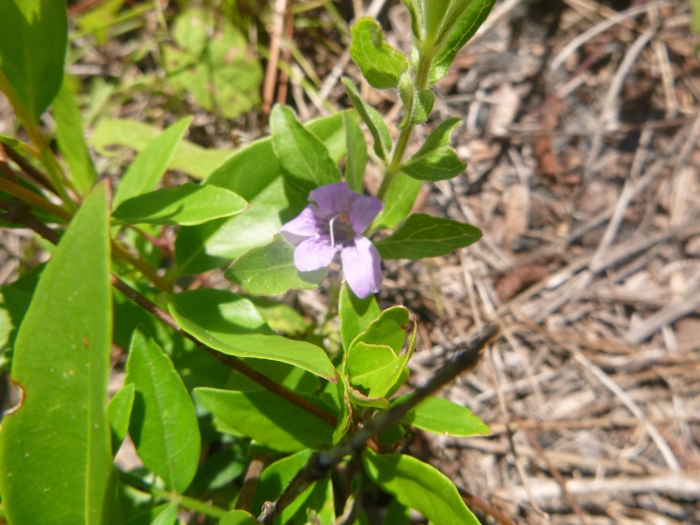Oblongleaf Snakeherb
(Dyschoriste oblongifolia)
Oblongleaf Snakeherb (Dyschoriste oblongifolia)
/
/

cwarneke
Public Domain
Image By:
cwarneke
Recorded By:
Copyright:
Public Domain
Copyright Notice:
Photo by: cwarneke | License Type: Public Domain | License URL: http://creativecommons.org/publicdomain/zero/1.0/ | Rights Holder: cwarneke | Publisher: iNaturalist | Date Created: 2017-05-27T12:19:27-07:00 |

























Estimated Native Range
Summary
Dyschoriste oblongifolia, commonly known as Oblongleaf Snakeherb or Twinflower, is a herbaceous, rhizomatous perennial that is deciduous in nature. It is native to open woodlands, savannas, and prairies in the southeastern United States. The plant typically grows to a height of 10–50 cm (4–20 in) and is known for its lavender flowers, which bloom from June to August. These flowers are subsessile, often appearing in pairs, with five lobes, four stamens, and a style 1.5 cm long, making them quite showy. The foliage is also attractive, with leaves that resemble the bracts surrounding the flowers.
Oblongleaf Snakeherb is valued for its adaptability to a range of soil conditions, from acidic to slightly alkaline, and its ability to thrive in sandy, loamy, or clay soils. Its high drought tolerance and low maintenance requirements make it an excellent choice for gardeners seeking a resilient groundcover. It is also used in butterfly gardens as a larval host for the common buckeye butterfly, contributing to local biodiversity. In cultivation, it prefers full sun to part shade and requires well-drained soil with medium to low water input. While it has low salt tolerance, it is otherwise a hardy plant with few disease or pest issues.CC BY-SA 4.0
Oblongleaf Snakeherb is valued for its adaptability to a range of soil conditions, from acidic to slightly alkaline, and its ability to thrive in sandy, loamy, or clay soils. Its high drought tolerance and low maintenance requirements make it an excellent choice for gardeners seeking a resilient groundcover. It is also used in butterfly gardens as a larval host for the common buckeye butterfly, contributing to local biodiversity. In cultivation, it prefers full sun to part shade and requires well-drained soil with medium to low water input. While it has low salt tolerance, it is otherwise a hardy plant with few disease or pest issues.CC BY-SA 4.0
Plant Description
- Plant Type: Herb
- Height: 2-3 feet
- Width: 2-3 feet
- Growth Rate: Moderate
- Flower Color: Purple
- Flowering Season: Spring, Summer
- Leaf Retention: Deciduous
Growth Requirements
- Sun: Full Sun, Part Shade
- Water: Medium, Low
- Drainage: Fast
Common Uses
Bee Garden, Bird Garden, Butterfly Garden, Groundcover, Low Maintenance, Street Planting
Natural Habitat
Native to open woodlands, savannas, and prairies in the southeastern United States
Other Names
Common Names: Blue Twinflower, Twinflower
Scientific Names: , Dyschoriste oblongifolia, Ruellia biflora, Ruellia oblongifolia, Calophanes oblongifolius, Dipteracanthus oblongifolius, Calophanes biflorus, Calophanes oblongifolius var. acutiusculus, Dipteracanthus biflorus, Dyschoriste oblongifolia f. glabra
GBIF Accepted Name: Dyschoriste oblongifolia (Michx.) Kuntze